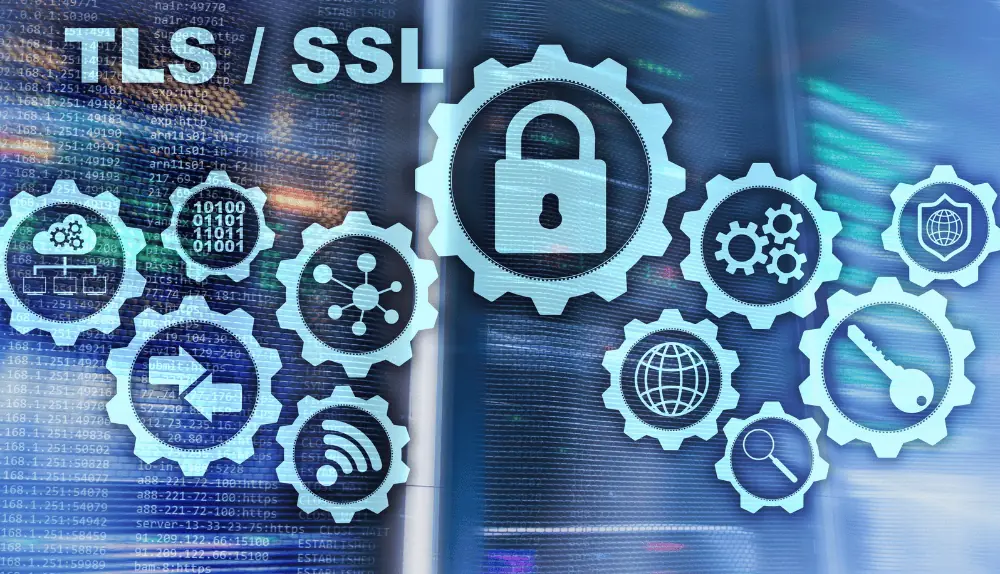In today’s fast-paced digital world, where cybersecurity threats are evolving at an alarming rate, businesses find themselves in a high-stakes battle to protect their sensitive data. Enter Transport Layer Security (TLS), a formidable shield against online vulnerabilities. According to recent studies, 95% of all internet traffic is now encrypted.
Without implementing TLS, businesses risk exposing their valuable information to potential cybercriminals lurking in the shadows. However, TLS offers more than just encryption; it adds an extra layer of protection through authentication and data integrity.
A recent survey revealed that companies employing TLS experienced a 50% reduction in data breaches compared to those without such measures. So, if businesses want to stay ahead of the game, build trust with their customers, and ward off cyber threats, adopting TLS is imperative in today’s digital landscape.
What is Transport Layer Security (TLS) Protocol?

Transport Layer Security (TLS) protocol, formerly known as Secure Sockets Layer (SSL), is a cryptographic protocol that provides secure communication over computer networks. It ensures the confidentiality, integrity, and authentication of data transmitted between clients (web browsers) and servers (websites or applications). TLS establishes an encrypted connection between the client and the server, preventing unauthorized parties from intercepting and tampering with the data being exchanged.
The protocol operates in a transport manner, meaning it works seamlessly behind the scenes without requiring significant changes to existing applications or network infrastructure. It achieves this by implementing security measures at the transport layer of the network stack, effectively encrypting data at the socket level. This enables secure communication between various endpoints, including web browsers and web servers, email clients and servers, and other network-based applications.
TLS combines symmetric and asymmetric encryption algorithms, digital certificates, and key exchange protocols to establish a secure connection. It provides end-to-end encryption, ensuring that data remains confidential and protected from eavesdropping throughout its transmission. Additionally, TLS includes mechanisms for verifying the authenticity of servers through digital certificates, thereby preventing man-in-the-middle attacks and ensuring that clients communicate with legitimate servers.
How Does Transport Layer Security Work?
TLS provides a secure and encrypted communication channel between a client and a server over a computer network. It ensures data confidentiality, integrity, and authentication between the two endpoints. Let’s take a closer look at how TLS provides a strong layer of security.

1. Handshake Phase
The TLS handshake is the first step in establishing a secure connection. During this phase, the client and server negotiate encryption techniques, exchange cryptographic keys, and verify each other’s identities.
- Client Hello: The TLS handshake starts with the client delivering a “Client Hello” message to the server, which includes the TLS version and encryption techniques supported.
- Server Hello: In response, the server sends a “Server Hello” message describing the encryption technique and other parameters.
- Certificate Exchange: The server supplies the client with its digital certificate containing the server’s public key and identifying information. The client validates the certificate’s authenticity using trusted certificate authorities (CAs) to guarantee it is talking with the intended server.
- Key Exchange: The client produces a random session key and encrypts it with the public key from the server’s certificate. The server then decrypts the session key with the appropriate private key.
2. Secure Data Transfer
Once the handshake is complete and all parties have agreed on the encryption parameters, the safe data transfer using symmetric encryption can begin.
- Symmetric Encryption: TLS uses symmetric encryption techniques, such as the Advanced Encryption Standard (AES), to encrypt data sent between the client and server. The handshake-derived shared session key is utilized for symmetric encryption, guaranteeing quick and efficient data encryption and decryption.
- Data Integrity: TLS protects data by attaching a Message Authentication Code (MAC) or Hash-based Message Authentication Code (HMAC) to each transmitted message. This allows the receiving party to ensure the data was not changed during transmission.
3. Session Management
Session Management: During an ongoing session, TLS retains session state information for efficient and secure communication between the client and server.
- Session Resumption: TLS offers session resumption, which allows clients to reconnect to a previously established connection without requiring a full handshake. This eliminates computational overhead while improving efficiency.
- Perfect Forward Secrecy (PFS): TLS can be set to provide Perfect Forward Secrecy, which assures that earlier transmitted sessions remain secure even if the server’s private key is compromised in the future. This is accomplished through temporary key exchange technologies such as Diffie-Hellman key exchange.
4. Secure Connection Termination
When the client or server decides to terminate the TLS connection, a secure closure process is initiated to ensure the session’s integrity until the conclusion.
- Closure notifications: To signify the intention to terminate the connection, both parties exchange closure notifications. These notifications ensure that any remaining data is securely delivered and received before the connection is terminated.
The Development of TLS Encryption

Transport Layer Security (TLS) encryption has grown through multiple generations, each iteration resolving weaknesses and offering innovations to strengthen online communication security. Let’s look at the critical milestones and advancements in TLS encryption development.
- SSL: The precursor to TLS, Secure Sockets Layer (SSL), was developed by Netscape Communications in the 1990s. SSL 1.0 was never publicly released due to security flaws. SSL 2.0, released in 1995, introduced encryption and authentication capabilities but had significant security vulnerabilities.
- SSL 3.0: In 1996, SSL 3.0 was released, offering improved security and performance. It introduced the concept of the handshake process, allowing for the negotiation of encryption algorithms and the exchange of digital certificates for authentication. However, SSL 3.0 suffered from vulnerabilities such as the POODLE attack (Padding Oracle On Downgraded Legacy Encryption) and was eventually deprecated.
- TLS 1.0: In response to the security issues in SSL 3.0, the Internet Engineering Task Force (IETF) developed Transport Layer Security (TLS) 1.0 as an improved and more secure successor. In 1999, TLS 1.0 incorporated various improvements over SSL 3.0, including stronger message integrity checks and enhanced vital exchange mechanisms. However, vulnerabilities such as BEAST (Browser Exploit Against SSL/TLS) and vulnerabilities in the Cipher Block Chaining (CBC) mode of operation led to the need for further iterations.
- TLS 1.1: Released in 2006, TLS 1.1 addressed the vulnerabilities present in TLS 1.0. It introduced more robust cryptographic algorithms and removed support for weaker ones. TLS 1.1 provided better protection against security threats, including the BEAST attack. However, the rapid advancements in computational power and cryptanalysis led to the need for further improvements.
- TLS 1.2: Introduced in 2008, TLS 1.2 significantly enhanced security and performance. It strengthened cryptographic algorithms, added support for authenticated encryption, and improved resilience against attacks. TLS 1.2 became the recommended version for secure communication, offering better protection against vulnerabilities like the Lucky Thirteen attack.
- TLS 1.3: The most recent major version of TLS, TLS 1.3, was finalized in 2018. It focused on improving security and performance. It eliminated obsolete and weaker cryptographic algorithms, reduced the number of round trips required during the handshake process, and introduced forward secrecy by default. TLS 1.3 also improved resistance against protocol downgrade attacks and timing attacks.
The necessity to handle growing threats and improve security standards has pushed the constant development and refining of TLS encryption. TLS 1.3, in particular, offers substantial security and performance advancement, providing organizations and users with a more robust and efficient encryption system.
Businesses must keep up with the latest TLS versions to guarantee they benefit from the latest security advances. By implementing TLS encryption in their online communication channels, organizations can protect sensitive data, increase consumer trust, and reduce the risk of data breaches and illegal access.
Why Should Businesses Use TLS?
Transport Layer Security (TLS) encryption has become critical in today’s interconnected and digitally driven business landscape. TLS has numerous advantages that make it essential for businesses to protect sensitive data, create trust with their consumers, and maintain a competitive edge. Let’s look at the reasons why organizations should prioritize TLS adoption.
Data Security and Confidentiality
TLS enables end-to-end encryption, guaranteeing that data sent between clients and servers is kept private and secure from snooping. This is especially important for firms that handle sensitive personal, financial, or proprietary data. Businesses can protect their brand and customers’ privacy by deploying TLS, which prevents unwanted access and mitigates the danger of data breaches.
Authentication and Trust
TLS uses digital certificates to validate the authenticity of servers, building confidence between clients and servers. This authentication system ensures that clients communicate with authorized servers, reducing the danger of man-in-the-middle attacks and other security issues. Businesses may demonstrate their commitment to security and develop trust with their customers by using TLS, fostering deeper relationships, and increasing customer loyalty.
Regulatory Compliance
Many industries are governed by severe data protection and privacy laws, such as the European Union’s General Data Protection Regulation (GDPR) or the Health Insurance Portability and Accountability Act (HIPAA) in the healthcare sector. Compliance with these standards avoids hefty fines and indicates a dedication to protecting customer privacy, improving brand reputation, and preventing legal issues. TLS encryption assists enterprises in meeting these compliance standards by offering a solid security method for sensitive data protection.
Secure Transaction and E-Commerce
TLS encryption is critical for safe online transactions, especially for e-commerce enterprises. It ensures that sensitive consumer information, such as credit card numbers or personal information, is securely transmitted over the internet, lowering the danger of interception and unwanted access. Businesses that use TLS create a safe environment for online transactions, increasing customer confidence and reducing cart abandonment rates.
Competitive Advantage
Businesses emphasizing security gain a substantial competitive advantage in an increasingly competitive digital landscape. TLS encryption distinguishes itself by ensuring clients that their data is secure and exhibiting a commitment to their privacy. Businesses can inspire confidence in consumers and potentially attract new ones by prominently displaying TLS security indications, such as the padlock symbol or “https” in the website URL.
Future-Proofing
Staying ahead of the curve is critical as technology and cyber threats grow. TLS is constantly upgraded and improved to handle new security concerns and vulnerabilities. Businesses that use TLS and stay up with the latest versions ensure they use the most effective encryption protocols available, bolstering their defenses against new and developing cyber threats.
In today’s digital landscape, enterprises must implement Transport Layer Security (TLS) encryption. TLS provides many compelling reasons for enterprises to prioritize its installation, ranging from data protection and confidentiality to authentication, trust-building, regulatory compliance, secure transactions, competitive advantage, and future-proofing. Businesses that invest in TLS encryption can protect sensitive data, increase consumer trust, meet regulatory obligations, and gain a competitive advantage, ultimately boosting their overall security posture and facilitating growth in the digital environment.
SSL vs. TLS vs. HTTPS
SSL (Secure Sockets Layer), TLS (Transport Layer Security), and HTTPS (Hypertext Transfer Protocol Secure) are all cryptographic protocols that provide secure communication over computer networks. While some differences exist, they are closely related and work together to ensure safe data transmission. Here’s a breakdown of SSL, TLS, and HTTPS:
SSL (Secure Sockets Layer)
SSL was the original protocol developed by Netscape Communications in the 1990s to secure online communications. It provides encryption, authentication, and data integrity for transmitting sensitive information online. However, due to security vulnerabilities, SSL is now considered deprecated and no longer recommended.
TLS (Transport Layer Security)
TLS is the successor to SSL and is the current industry standard for secure communication. It builds upon the foundations of SSL and offers improved security and performance. TLS includes enhancements such as stronger encryption algorithms, better authentication mechanisms, and resistance against known vulnerabilities. TLS versions, such as TLS 1.2 and TLS 1.3, are widely used today to establish secure connections between clients and servers.
HTTPS (Hypertext Transfer Protocol Secure)
HTTPS incorporates TLS or SSL protocols to encrypt and secure data transmission. HTTPS is the secure version of the HTTP protocol, which transfers data over the internet. When a website uses HTTPS, communication between the web browser and the web server is encrypted, ensuring that sensitive information such as login credentials, financial data, or personal information is protected from unauthorized access.
In essence, SSL and TLS are cryptographic protocols that provide security features for data transmission, with TLS being the more modern and secure version. HTTPS, on the other hand, combines the HTTP protocol and SSL/TLS encryption. It indicates that a website uses a secure connection and provides end-to-end encryption for the data between the client and the server.
In recent years, HTTPS has gained significant importance, with major browsers and search engines encouraging website owners to adopt HTTPS to enhance security and protect user privacy. It has become a standard practice for websites, particularly those involving e-commerce, online banking, and sensitive data transactions, to use HTTPS to ensure secure communication and build user trust.
Pros and Cons of TLS Certificate

TLS certificates, also known as SSL certificates, are crucial in establishing secure and trusted connections over the internet. While they offer numerous benefits, they also come with certain considerations. Let’s explore the pros and cons of TLS certificates:
Pros
- Encryption and Data Security: TLS certificates enable encryption of data transmitted between clients and servers. This ensures that sensitive information remains confidential and protected from eavesdropping or interception by unauthorized parties.
- Authentication and Trust: TLS certificates provide authentication mechanisms, verifying the server’s identity and ensuring that clients communicate with legitimate and trusted servers. This establishes trust between users and websites, mitigating the risk of man-in-the-middle attacks and enhancing overall security.
- Regulatory Compliance: Many industries and jurisdictions require TLS certificates to comply with data protection and privacy regulations. Having a valid TLS certificate helps businesses demonstrate compliance with these regulations, avoiding penalties and legal complications.
- Improved Search Engine Ranking: Search engines like Google treat HTTPS websites with valid TLS certificates and preferential treatment. This can result in better search engine rankings and increased visibility, leading to higher website traffic and potential business opportunities.
- Enhanced User Confidence: Displaying a padlock symbol and “https” in the website URL indicates a secure connection, instilling confidence in users and reassuring them that their data is protected. This can increase user trust, reduce bounce rates, and improve conversion rates.
Cons
- Cost: Obtaining and maintaining TLS certificates typically costs, especially for higher-level certificates that provide more robust encryption and authentication. The price can be a barrier for small businesses or individuals with budget constraints.
- Certificate Management: Managing TLS certificates can be complex, especially for organizations with numerous websites or servers. Certificate issuance, renewal, and installation require careful attention to ensure continuous security, which may require dedicated resources or certificate management tools.
- Certificate Expiration: TLS certificates have an expiration date, typically ranging from a few months to a few years. Failing to renew certificates before they expire can result in disruptions to website access and potential security risks if users encounter certificate warnings or errors.
- Certificate Trust and Verification: TLS certificates are issued by Certificate Authorities (CAs), and the trustworthiness of CAs is crucial. If a CA is compromised or issues fraudulent certificates, it can undermine the security and trust of TLS connections. However, efforts such as Certificate Transparency have been implemented to enhance the transparency and accountability of CAs.
Overall, the benefits of TLS certificates, including encryption, authentication, compliance, and user trust, outweigh the challenges. While costs and certificate management require consideration, the increased security and confidence they provide are invaluable for organizations seeking to protect sensitive data, build trust, and maintain a secure online presence.
How TLS Protects Payments?

TLS (Transport Layer Security) plays a critical role in protecting payments and ensuring the security of financial transactions conducted over the internet. When it comes to payment processing, TLS provides several layers of protection.
Firstly, TLS establishes a secure and encrypted communication channel between the user’s browser (client) and the payment gateway or server (merchant). This encryption prevents unauthorized parties from intercepting and accessing sensitive payment information, such as credit card details or personal data, during transmission. By encrypting the data, TLS ensures that it remains confidential and cannot be easily deciphered even if it is intercepted.
Secondly, TLS provides authentication mechanisms that verify the identity of the server. This is achieved through the use of digital certificates issued by trusted Certificate Authorities (CAs). The certificates contain information about the server, including its public key, and are used to establish trust between the client and the server. When a user accesses a payment page, the TLS certificate is checked to ensure it is valid and matches the server’s identity. This authentication process helps protect against man-in-the-middle attacks, where a malicious actor impersonates the server to intercept payment information.
Furthermore, TLS ensures data integrity during payment transactions. It achieves this by appending a Message Authentication Code (MAC) or Hash-based Message Authentication Code (HMAC) to each transmitted message. These codes enable the recipient to verify that the data has not been tampered with or altered during transmission. If any modifications are detected, the recipient knows the data has been compromised, and the transaction can be rejected.
In addition to encryption, authentication, and data integrity, TLS also supports Perfect Forward Secrecy (PFS) for payment transactions. PFS ensures that even if the server’s private key is compromised in the future, previously transmitted transactions remain secure. This is accomplished by using ephemeral key exchange mechanisms, such as the Diffie-Hellman key exchange, which generates unique session keys for each transaction. With PFS, compromising a single key does not affect the security of past or future transactions.
By leveraging TLS, payment processors and e-commerce platforms can provide a secure environment for online transactions. TLS protects sensitive payment information, builds customer trust, and helps businesses comply with industry regulations. It ensures that payment data is encrypted, authenticated, and transmitted with integrity, safeguarding against unauthorized access, data breaches, and fraudulent activities. Ultimately, TLS enables secure and seamless online payments, contributing to the growth of e-commerce and digital transactions.
Final Words
In conclusion, Transport Layer Security (TLS) encryption is crucial in securing online payments. TLS provides robust encryption, authentication, and data integrity, protecting sensitive information and establishing trust between users and servers.
By adopting TLS, businesses can enhance customer confidence, meet regulatory requirements, and ensure secure payment transactions. Despite considerations such as costs and certificate management, the benefits of TLS far outweigh the challenges. Prioritizing TLS enables organizations to safeguard data, build trust, and navigate the evolving landscape of online payments effectively.

